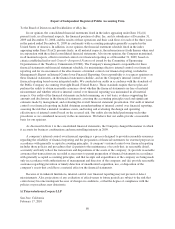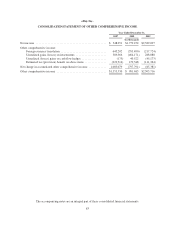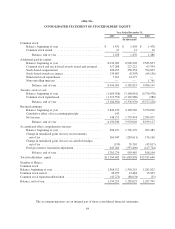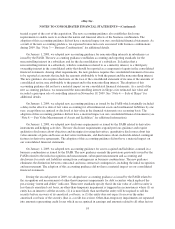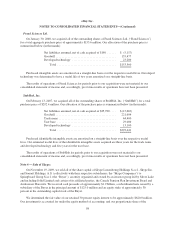eBay 2009 Annual Report Download - page 96
Download and view the complete annual report
Please find page 96 of the 2009 eBay annual report below. You can navigate through the pages in the report by either clicking on the pages listed below, or by using the keyword search tool below to find specific information within the annual report.eBay Inc.
NOTES TO CONSOLIDATED FINANCIAL STATEMENTS—(Continued)
Foreign currency
Most of our foreign subsidiaries use the local currency of their respective countries as their functional
currency. Assets and liabilities are translated at exchange rates prevailing at the balance sheet dates. Revenues,
costs and expenses are translated into U.S. dollars at average exchange rates for the period. Gains and losses
resulting from the translation of our consolidated balance sheet are recorded as a component of accumulated
other comprehensive income.
Realized gains and losses from foreign currency transactions are recognized as interest and other income,
net.
Derivative instruments
We have significant international revenues as well as costs denominated in foreign currencies, subjecting us
to foreign currency risk. We purchase foreign currency exchange contracts that qualify as cash flow hedges,
generally with maturities of 12 months or less, to reduce the volatility of cash flows primarily related to
forecasted revenue and intercompany transactions denominated in certain foreign currencies. All outstanding
derivatives that qualify for hedge accounting are recognized on the balance sheet at fair value, and changes in
their fair value are recorded in accumulated other comprehensive income (loss) until the underlying forecasted
transaction occurs. The effective portion of the derivative’s gain or loss is initially reported as a component of
accumulated other comprehensive income (loss), and is subsequently reclassified into the financial statement line
item in which the hedged item is recorded in the same period the forecasted transaction affects earnings. We also
hedge our exposure to foreign currency denominated monetary assets and liabilities with foreign currency
contracts. Since these derivatives hedge existing exposures that are denominated in foreign currencies, the
contracts do not qualify for hedge accounting. Accordingly, these outstanding non-designated derivatives are
recognized on the balance sheet at fair value and changes in fair value from these contracts are recorded in
interest and other income, net, in the consolidated statement of income. Our derivatives program is not designed
or operated for trading or speculative purposes.
Our derivative instruments expose us to credit risk to the extent that our counterparties may be unable to
meet the terms of the agreements. We seek to mitigate this risk by limiting our counterparties to major financial
institutions and by spreading the risk across several major financial institutions. In addition, the potential risk of
loss with any one counterparty resulting from this type of credit risk is monitored on an ongoing basis. See
“Note 9 — Derivative Instruments” for additional information related to our derivative instruments.
Concentrations of credit risk
Our cash, cash equivalents, accounts receivable, loans receivable, funds receivable and customer accounts
are potentially subject to concentration of credit risk. In addition funds receivable are generated with banks or
credit card companies that management believes are of high credit quality. Cash and cash equivalents and
customer accounts are placed with financial institutions that management believes are of high credit quality. Our
accounts receivable are derived from revenue earned from customers located in the U.S. and internationally. Our
loans receivable are derived from consumer financing activities for customers located in the U.S. We maintain an
allowance for doubtful accounts receivable, authorized credits and loans receivable based upon our historical
experience, the age and delinquency rates of receivables and the credit quality of the relevant loan, as well as
economic and regulatory conditions. Determining appropriate allowances for these losses is an inherently
uncertain process, and ultimate losses may vary from the current estimates, resulting in a material impact to
future statements of income or cash flows. Due to the relatively small dollar amount of individual accounts
receivable and loans and interest receivable, we generally do not require collateral on these balances. The
88




